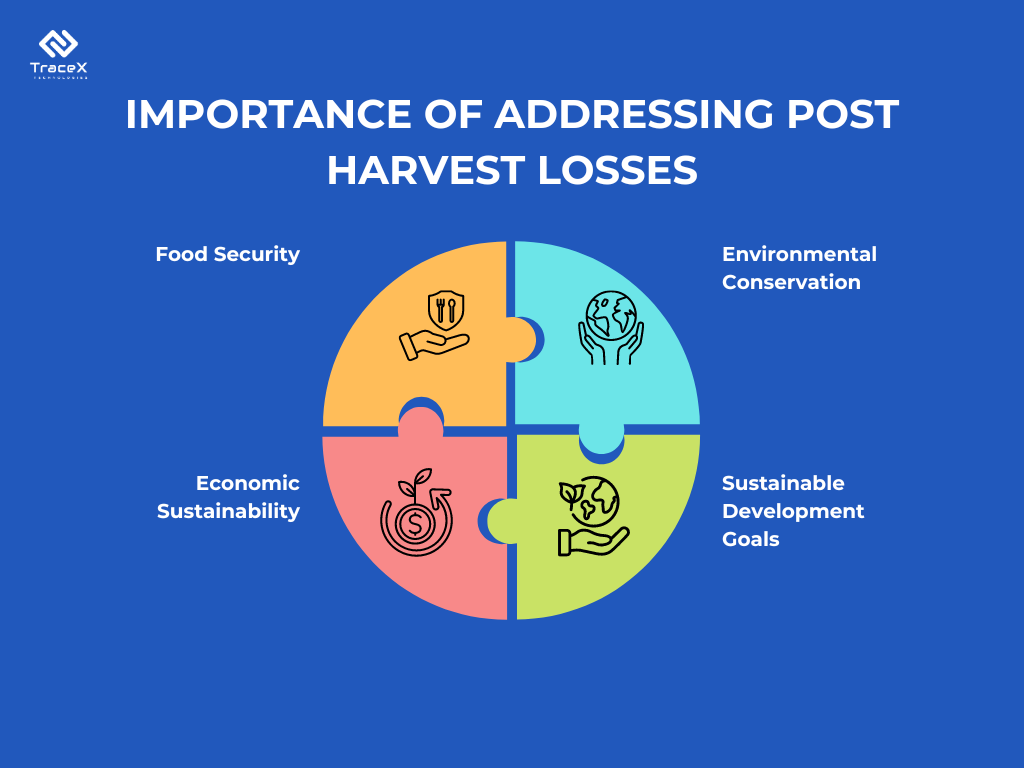Contact: +91 99725 24322 |
Menu
Menu
Quick summary: Learn how addressing post-harvest losses in agricultural value chains can enhance food security, reduce economic losses, and mitigate environmental impacts. Explore strategies, impacts, and technological solutions like TraceX for a more sustainable food system.

The journey of our food from farm to table is often fraught with unseen challenges. While we may not realize it, a significant portion of agricultural produce is lost after harvest. This translates to a double blow: wasted resources and reduced income for farmers. In the intricate web of agricultural production and distribution, post-harvest losses stand as a significant challenge, silently eroding the efforts of farmers and the resources invested in cultivation. As crops traverse from farm to table, a considerable portion is lost or wasted due to various factors, posing threats to food security, economic stability, and environmental sustainability.
With the global population expected to reach ten billion by 2050, a 56 percent increase in food production from 2010 levels will be necessary. However, studies indicate that agricultural production worldwide may struggle to meet this heightened demand for food.
Approximately 1.3 billion tonnes of food are lost annually worldwide. More than 40 percent of this loss occurs throughout commodity supply chains at the postharvest level (between harvest and the consumer) in many developing economies, including those in Africa, Asia, and Latin America
Post-harvest losses refer to the decrease in quantity or quality of food commodities that occurs between harvest and consumption. This includes losses during handling, storage, transportation, processing, and distribution stages of the agricultural value chain. Factors contributing to post-harvest losses vary widely and can include inadequate infrastructure, poor handling practices, lack of access to markets, and environmental conditions such as temperature and humidity fluctuations.
As per latest estimates by the Associated Chambers of Commerce of India, India loses approximately INR 926 bn (US$ 14.33 bn) on account of Post harvest Losses.


Physical damage to agricultural produce during harvesting and handling can occur due to improper techniques, equipment, or tools. Rough handling, mechanical injury, bruising, and crushing can lead to the deterioration of fruits, vegetables, grains, and other commodities. Additionally, harvesting at inappropriate stages of maturity or under unfavorable weather conditions can exacerbate physical damage.
Inadequate storage facilities, including warehouses, silos, and cold storage units, contribute significantly to post-harvest losses. Improper storage conditions such as inadequate ventilation, temperature fluctuations, and high humidity levels can promote spoilage, mold growth, and pest infestations. Moreover, limited access to reliable electricity and refrigeration facilities further exacerbates the problem, especially in remote or rural areas.
Pests and diseases pose a significant threat to stored agricultural commodities, leading to spoilage and quality deterioration. Insects, rodents, fungi, and bacteria can infest stored grains, fruits, and vegetables, causing contamination, mold growth, and decay. Without proper pest management strategies and hygiene practices, post-harvest losses due to pests and diseases can be substantial.
Inefficient transportation systems and logistics contribute to post-harvest losses by prolonging transit times, exposing perishable goods to adverse conditions, and increasing the likelihood of damage and spoilage. Lack of proper handling facilities, inadequate packaging, and rough handling during transit can further exacerbate losses. Additionally, delays in transportation due to traffic congestion, road conditions, or logistical challenges can compromise the quality and freshness of agricultural produce.
Elaborating on these causes of post-harvest losses underscores the multifaceted nature of the problem and the need for comprehensive solutions to address each contributing factor effectively.
Post-harvest losses result in significant economic losses for farmers, producers, and other stakeholders along the agricultural value chain. Reduced yields, lower market prices for damaged or spoiled produce, and increased production costs due to wastage of inputs such as seeds, fertilizers, and labor contribute to financial setbacks. These losses not only affect the livelihoods and income of farmers but also impact the profitability and sustainability of agricultural enterprises, hindering economic growth and development in rural areas.
Post-harvest losses have profound implications for food security, particularly in regions where food availability is already limited. The loss of nutritious food items such as fruits, vegetables, grains, and pulses further exacerbates food shortages, malnutrition, and hunger. Inadequate access to safe and nutritious food due to losses in quantity and quality undermines efforts to achieve food security and nutrition goals, perpetuating cycles of poverty and food insecurity among vulnerable populations.
Post-harvest losses contribute to environmental degradation and resource wastage, exacerbating the ecological footprint of agriculture. Decomposing organic matter from spoiled produce releases greenhouse gases such as methane (CH4) and carbon dioxide (CO2) into the atmosphere, contributing to climate change and global warming. Moreover, the inefficient use of natural resources such as water, land, and energy in the production of lost or wasted food further strains ecosystems and exacerbates environmental challenges.
Post-harvest losses have socio-economic consequences for communities, including diminished livelihood opportunities, reduced income, and increased vulnerability to poverty and food insecurity. In rural areas where agriculture is the primary source of livelihood, losses in agricultural productivity undermine rural development efforts and perpetuate cycles of poverty. Additionally, food loss and waste perpetuate inequalities, as marginalized communities often bear the brunt of food insecurity and nutritional deficiencies.
By implementing proper harvesting techniques and handling practices, farmers can minimize physical damage to crops during harvesting and post-harvest handling. Training programs and extension services can educate farmers on best practices such as harvesting at the right maturity stage, using appropriate tools and equipment, and minimizing bruising and mechanical injury to crops during handling.
Inadequate storage facilities and infrastructure are major contributors to post-harvest losses. Investing in improved storage facilities such as warehouses, cold storage units, silos, and drying facilities can help preserve the quality and shelf life of harvested produce. Proper storage conditions, including temperature and humidity control, ventilation, and pest management, are essential to prevent spoilage and deterioration of stored crops.
Pest infestations and diseases pose significant risks to harvested crops during storage and transportation. Implementing integrated pest management (IPM) practices, including the use of biological control agents, crop rotation, and sanitation measures, can help minimize losses due to pests and diseases. Early detection and monitoring of pests and diseases, along with timely intervention measures such as chemical treatments or biopesticides, are crucial for preventing outbreaks and mitigating losses.
Efficient transportation and logistics are essential for minimizing transit losses and ensuring timely delivery of harvested produce to markets. Investing in transportation infrastructure, including roads, railways, and cold chain logistics, can improve the efficiency and reliability of supply chain operations. Adopting appropriate packaging materials and handling techniques during transportation, such as proper stacking and loading practices, can also reduce losses due to physical damage and spoilage. Furthermore, leveraging technology solutions such as GPS tracking, temperature monitoring, and real-time data analytics can enhance visibility and traceability throughout the transportation process, enabling proactive management of logistical challenges and minimizing losses.
Digitalization and data-driven approaches revolutionize post-harvest management by providing real-time monitoring, predictive analytics, and decision support systems for optimizing supply chain operations. IoT (Internet of Things) devices, sensors, and smart monitoring systems enable continuous monitoring of critical parameters such as temperature, humidity, and gas concentrations in storage facilities and transportation vehicles. By collecting and analyzing data on environmental conditions, product quality, and logistics performance, stakeholders can identify potential risks, detect anomalies, and take proactive measures to prevent losses. Furthermore, digital platforms and mobile applications facilitate seamless communication, collaboration, and information sharing among farmers, suppliers, distributors, and retailers, streamlining supply chain processes and enhancing transparency.
Traceability solutions play a vital role in post-harvest management by enabling end-to-end visibility and accountability throughout the supply chain. By leveraging technologies such as blockchain, RFID (Radio Frequency Identification), and barcode scanning, stakeholders can track the movement of produce from farm to fork, recording key information such as origin, cultivation practices, handling procedures, and quality attributes. Traceability systems enhance transparency, traceability, and authenticity, enabling rapid identification and recall of contaminated or compromised products, reducing food safety risks, and building consumer trust. Moreover, traceability data can facilitate product differentiation, quality assurance, and compliance with regulatory requirements, opening up opportunities for value-added marketing and premium pricing.
TraceX blockchain traceability solutions address post-harvest challenges in agricultural supply chains by providing end-to-end visibility, transparency, and accountability throughout the supply chain.
Streamlined procurement processes play a crucial role in minimizing post-harvest losses by ensuring efficient and timely sourcing of agricultural produce from farmers.
1. Reduced Harvest Delays: Streamlined procurement processes enable buyers to communicate their demand and specifications to farmers in advance. Farmers can then plan their harvest schedules accordingly, ensuring that produce is harvested at the optimal ripeness and maturity levels. This reduces the risk of overripening, spoilage, and quality deterioration in the field, minimizing post-harvest losses.
2. Optimized Supply Chain Logistics: Streamlined procurement processes facilitate better coordination and collaboration between farmers, suppliers, and logistics providers. By accurately forecasting demand and coordinating transportation schedules, buyers can ensure that harvested produce is promptly collected from farms and transported to processing facilities or distribution centers. This minimizes delays in transit, reduces handling and storage times, and prevents bottlenecks in the supply chain that can lead to spoilage and losses.
3. Improved Quality Control: Streamlined procurement processes often incorporate quality assurance measures and standards for agricultural produce. Buyers can specify quality parameters, such as size, color, texture, and freshness, ensuring that only high-quality produce meeting these standards is procured. This reduces the likelihood of substandard or damaged produce entering the supply chain, minimizing rejection rates, and post-harvest losses downstream.
4. Enhanced Traceability and Transparency: Streamlined procurement processes leverage digital platforms and traceability solutions to track the movement of produce from farm to fork. By capturing data on harvest dates, farm locations, handling practices, and transportation routes, stakeholders can trace the origin of each batch of produce and monitor its journey through the supply chain in real-time. This transparency enables early detection of issues such as delays, deviations from specifications, or quality concerns, allowing stakeholders to take proactive measures to mitigate losses and ensure product integrity.
In conclusion, addressing post-harvest losses in agricultural value chains is imperative for achieving food security, reducing economic losses, and mitigating environmental impacts. By implementing strategies such as improving harvesting practices, investing in better storage facilities, implementing pest management strategies, and leveraging technological solutions like TraceX, we can significantly minimize post-harvest losses and ensure a more sustainable and resilient food system for the future. It is essential for stakeholders across the agricultural value chain to collaborate and prioritize efforts to tackle this critical issue effectively.
